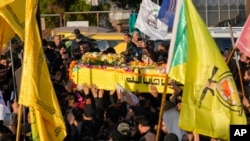The United States is giving no indication of relenting after its latest airstrike in Iraq — targeting an Iranian-backed militia commander in downtown Baghdad — sparked renewed anger and fresh calls for the removal of U.S. troops from the country.
Instead, officials in Washington on Thursday defended Tuesday’s strike and warned that the U.S. would not hesitate to act again should its forces come under further attacks.
"We fully respect Iraq’s sovereignty,” White House National Security Council spokesperson John Kirby told reporters. “But, look, if there were no attacks on our troops, who are there at the invitation of the Iraqi government, there would be no need for retaliatory strikes.”
Multiple U.S. military officials sent a similar message from the Pentagon.
"If you attack and you hurt our people, we know who you are, and we will find you," said General Daniel Hokanson, the U.S. National Guard bureau chief, regarding the U.S. response to last month’s attack on a base in Jordan that killed three soldiers and injured 40 National Guard troops.
“There will be a bill to pay much greater than anything that was left on us,” he added.
The U.S. has blamed Iranian-backed militias, operating under the banner of the Islamic Resistance in Iraq, for the deadly attack on the Tower 22 base in Jordan, as well as for many of the 168 attacks on U.S. forces in Iraq and Syria dating to mid-October.
Washington’s gaze, in particular, has fallen on Kataib Hezbollah, with some Pentagon officials going as far as to say that the attack in Jordan "bears the hallmarks” of the prominent Iranian-backed group.
Tuesday’s airstrike targeted senior Kataib Hezbollah commander Wisam Mohammad al-Saedi.
Initial U.S. statements said al-Saedi was “responsible for directly planning and participating in attacks on U.S. forces in the region.” But a U.S. official said Thursday that he was the top Kataib Hezbollah official for Syria, overseeing all operations in the country.
The strike killing al-Saedi followed a wave of airstrikes last Friday on seven locations used by the Iranian-backed militias in Syria and Iraq.
U.S. defense officials now believe those strikes destroyed more than 80 individual targets and killed or wounded 40 militia members.
Yet the repeated strikes have stoked growing anger among Iraqi officials.
Iraqi military spokesman Yehia Rasool early Thursday called the strike that killed al-Saedi “a blatant assassination” that showed “no regard for civilian lives or international laws.”
“The trajectory compels the Iraqi government more than ever to terminate the mission of this coalition, which has become a factor for instability and threatens to entangle Iraq in the cycle of conflict,” he said in a statement posted on social media.
A social media post from the office of Iraqi Prime Minister Mohamed Shia al-Sudani likewise indicated it was time for U.S. troops, and those from the U.S.-led coalition against the Islamic State terror group, to leave.
The prime minister “highlighted Iraq's enhanced capabilities in combating terrorism, leading to the decision to end the coalition's mission as ISIS terrorist remnants no longer pose a threat to Iraq,” the post said, using an acronym for the Islamic State, also known as IS or Daesh.
The U.S. has about 2,500 troops in Iraq tasked with advising and assisting Iraqi Security Forces as they pursue the remnants of IS. Another 900 U.S. forces are stationed in Syria, charged with the same mission.
And while the U.S. has been in talks with Iraq about eventually reducing the U.S. military footprint and transitioning from the counter-IS mission, officials suggested Thursday that the time has not yet come.
“In Iraq and Syria, they are down, but they're not out,” said Pentagon press secretary Major General Patrick Ryder. “And so, again, this work by an international coalition continues to try to prevent a resurgence.”
Ryder further called IS “insidious” when it comes to taking advantage of turmoil, adding, “It's obviously not helpful when you have things like Iranian proxies attacking your forces that are there for that mission.”
U.S. counterterrorism and intelligence officials have estimated there are fewer than 2,000 IS fighters across Iraq and Syria, though some key allies have recently warned the terror group is resurging, carrying out more attacks while seeing its ranks grow.
It is a warning the U.S.-backed Syrian Democratic Forces, or SDF, repeated Thursday.
“We have seen a spike in movements of ISIS,” said SDF commander General Mazloum Abdi, talking to reporters in Washington by video link from his headquarters in northeastern Syria.
Abdi also warned that the group is “taking a benefit” from the constant attacks by the Iranian-backed militias, who have started targeting SDF positions in addition to their drone and missile attacks on U.S. forces.
“We do not have any protection measures against them," he said through a translator, adding that the SDF has requested anti-drone defense systems from Washington.
One attack, against the SDF base at the Omar Oil Field this past Sunday, killed six SDF fighters.
Abdi said another drone attack came close to hitting a prison in Hasakah, one of dozens of facilities holding a total of about 9,000 captured IS fighters. He said one drone hit the prison’s roof, but that fortunately, U.S. forces downed the other three before they could do more serious damage.
Despite the precarious situation, the SDF commander said he was not worried U.S. forces would be leaving in the short term.
"We have been reassured by United States officials ... there's not going to be any withdrawal [from Syria] anytime soon," Abdi said, warning that should the U.S. change course, the result would be chaos.
“Many actors, forces, will be trying to take advantage,” he said. “U.S. presence on the ground is a main factor maintaining balance here."
VOA Pentagon Correspondent Carla Babb and White House Bureau Chief Patsy Widakuswara contributed to this report.












